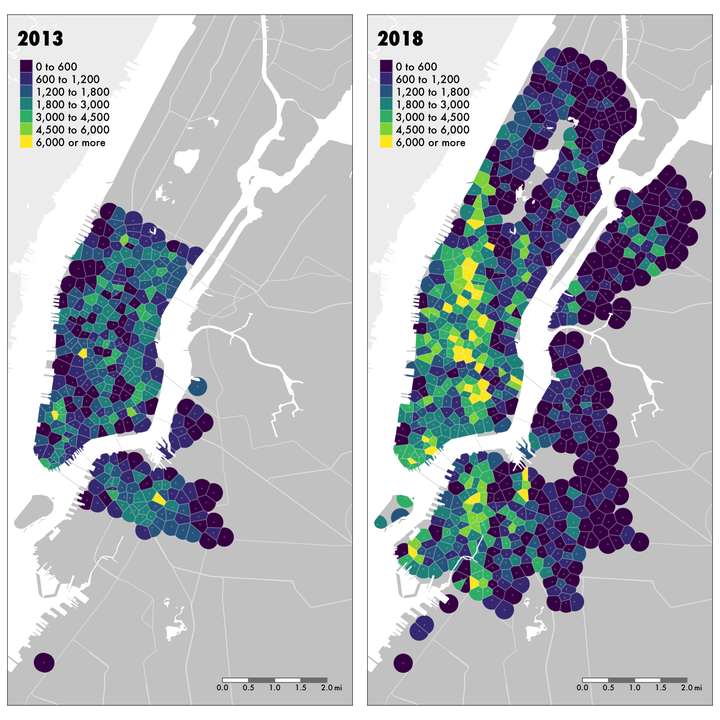
Abstract
This report, in collaboration with New York Communities for Change, examines the Citi Bike network from an economic and racial equity perspective, using spatial analysis to investigate the extent to which bike sharing helps to improve mobility options for New Yorkers most in need of such options. Our analysis finds that the Citi Bike network mainly serves a privileged population that already has strong transit options. Future expansions of bike sharing in NYC, either through the existing Citi Bike system or through the introduction of new competitors, should expand the effective size of the population who can access the subway in neighborhoods of high social need.
Executive summary
This report examines the Citi Bike network from an economic and racial equity perspective, using spatial analysis to investigate the extent to which bike sharing helps to improve mobility options for New Yorkers most in need of such options. Specifically, we ask the following questions:
- Who has access to Citi Bike, and who doesn’t?
- How have the populations with access to Citi Bike changed since 2013?
- Which neighborhoods use Citi Bike, and which don’t?
- How should bike sharing expand in the future to address existing inequities and gaps in the transit system?
Our analysis finds that the Citi Bike network mainly serves a privileged population that already has strong transit options. Future expansions of bike sharing in NYC, either through the existing Citi Bike system or through the introduction of new competitors, should expand the effective size of the population who can access the subway in neighborhoods of high social need.
Key findings
- Citi Bike serves the wealthiest, most privileged part of New York City. More than three quarters (76.8%) of New Yorkers do not have access to bike sharing, and the remaining 23.2% who do are wealthier, whiter and better educated than the rest of the city.
- People with access to Citi Bike are wealthier than those without access, with a median household income of $90,400 in service areas versus $54,700 outside service areas.
- The poorest parts of New York mostly lack bike sharing access, while the wealthiest parts of New York City are all located within Citi Bike’s service area. More than 7 in 10 of the neighborhoods with median household income under $20,000 lack bike sharing, while every neighborhood with a median household income higher than $200,000 has access.
- Citi Bike serves disproportionately few New Yorkers in poverty. While 20.3% of New Yorkers without bike sharing access live in poverty, this figure drops to 15.9% for New Yorkers with access. Meanwhile, three-quarters of neighborhoods in extreme poverty (where at least 45% of the population falls under the poverty threshold) are located outside the Citi Bike service area.
- Citi Bike serves disproportionately few New Yorkers of color; its service area is twice as white as the rest of the city. Just under a third (32.1%) of New Yorkers are non-Hispanic white, but more than half of people within Citi Bike’s service area are. Only 16.5% of people of color in New York City have access to bike sharing services, while 37.5% of white New Yorkers do.
- People with access to Citi Bike are more educated than those without. 47.5% of the population with access to Citi Bike hold a bachelor’s degree or higher. Only 19.0% of the population without bike sharing access have a bachelor’s degree.
- Citi Bike overwhelmingly serves people who already have subway access. 2.5 million New Yorkers live further than half a mile from the subway, and only 94,000 of them (3.8%) have Citi Bike stations. But 95.3% of those with Citi Bike access also live close to the subway.
- 22.1% of the city’s population has access to both Citi Bike and the subway; 27.8% has access to neither. Those who have access to both are wealthier (median household income of $92,100 vs. $66,500), and whiter (52.7% vs. 31.2%), and have higher rates of educational attainment (48.4% have a bachelor’s degree or higher vs. 20.6%).
- 1.2 million New York residents have gained access to Citi Bike since 2013, but only 48,700 of them are underprivileged people lacking subway access. The remaining 1.1 million are only slightly more diverse and less affluent than the original population with bike sharing, with a median household income of $84,900 (compared to $54,700 in the portion of the city without bike sharing access) and a poverty rate of 16.6% (compared with 20.2% in the area without bike service), half are white (49.9% compared with 26.2% elsewhere), and 44.9% have at least a bachelor’s degree (compared to 19.0% elsewhere).
- Citi Bike ridership increases the wealthier, whiter and better educated the surrounding area is, but the effect is small, and largely driven by the fact that ridership is highest near Broadway in Manhattan.
- 760,000 disproportionately poor and non-white New Yorkers without good subway access would benefit from an equity-focused bike sharing network expansion. The most equitable way to expand bike sharing would be to prioritize areas just out of reach of subway access and have high social need. We have identified twelve such neighborhoods across four boroughs. Building new bike sharing facilities to connect people to the subway would greatly improve accessibility for 760,000 people who are 85.9% non-white with a median household income of $50,800. In total, under the most aggressive expansion scenario, up to 3.7 million New Yorkers could gain bike sharing access.
The report is available to download here .